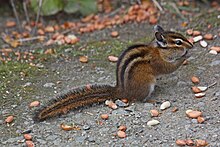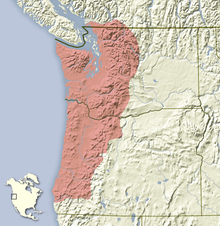Townsend's chipmunk
| Townsend's chipmunk | |
|---|---|
 | |
Conservation status | |
| Scientific classification | |
| Domain: | Eukaryota |
| Kingdom: | Animalia |
| Phylum: | Chordata |
| Class: | Mammalia |
| Order: | Rodentia |
| Family: | Sciuridae |
| Genus: | Neotamias |
| Species: | N. townsendii |
| Binomial name | |
| Neotamias townsendii (Bachman, 1839) | |
 | |
| Synonyms | |
| Tamias townsendii Bachman, 1839 | |
Townsend's chipmunk (Neotamias townsendii) is a species of rodent in the squirrel family, Sciuridae. It lives in the forests of the Pacific Northwest of North America, from extreme southwestern British Columbia through western Washington and western Oregon. Townsend's chipmunk is named after John Kirk Townsend, an early 19th-century ornithologist.[2]
Description
A large chipmunk, adults can be 36 cm (14 in) from nose to the tip of its tail. In much of its range, it is the only chipmunk; it can be identified by its tail which is grayish above and reddish below, and by its brown coloration with indistinct tawny stripes.
Biology

Townsend's chipmunk hibernates in regions where the winter is harsh, but in other parts of its range that have a more mild climate it can be active year-round. It is omnivorous, eating a variety of plants and insects and even birds' eggs.[3] Townsend's chipmunks in the Oregon Coast Range have higher population densities in areas with dense shrubbery, especially salal (Gaultheria shallon).[4] In the summer and early fall, Townsend's chipmunks eat blackberries, salal berries, and thimble berries. In the late fall, they eat acorns, huckleberries, maple seeds, thistle seeds, grain seeds, grass, roots, and conifer seeds.[citation needed]
References
- ^ Linzey, A. V. & Hammerson, G. (2008). "Neotamias townsendii". IUCN Red List of Threatened Species. 2008. Retrieved 8 January 2009.old-form url
- ^ Ornithology of the United States of North America, John Kirk Townsend, 1839
- ^ Hartson, Tamara (1999). Squirrels of the West. Lone Pine Publishing. pp. 22, 12–56. ISBN 1-55105-215-6.
- ^ Hayes, John P.; Horvath, Eric G.; Hounihan, Patrick (January 1995). "Townsend's chipmunk populations in Douglas-fir plantations and mature forests in the Oregon Coast Range". Canadian Journal of Zoology. 73. Ottawa: National Research Council: 67–73. doi:10.1139/z95-008. ISSN 1480-3283. Retrieved 16 January 2010.
- v
- t
- e
(antelope squirrels)
- Harris's antelope squirrel (A. harrisii)
- Espíritu Santo antelope squirrel (A. insularis)
- Texas antelope squirrel (A. interpres)
- White-tailed antelope squirrel (A. leucurus)
- San Joaquin antelope squirrel (A. nelsoni)
(golden-mantled ground squirrels)
- Golden-mantled ground squirrel (C. lateralis)
- Sierra Madre ground squirrel (C. madrensis)
- Cascade golden-mantled ground squirrel (C. saturatus)
(prairie dogs)
- Gunnison's prairie dog (C. gunnisoni)
- White-tailed prairie dog (C. leucurus)
- Black-tailed prairie dog (C. ludovicianus)
- Mexican prairie dog (C. mexicanus)
- Utah prairie dog (C. parvidens)
- Siberian chipmunk (E. sibiricus)
(little ground squirrels)
- Mexican ground squirrel (I. mexicanus)
- Rio Grande ground squirrel (I. parvidens)
- Thirteen-lined ground squirrel (I. tridecemlineatus)
(marmots)
- Bobak marmot (M. bobak)
- Alaska marmot (M. broweri)
- Black-capped marmot (M. camtschatica)
- Long-tailed marmot (M. caudata)
- Himalayan marmot (M. himalayana)
- Alpine marmot (M. marmota)
- Menzbier's marmot (M. menzbieri)
- Groundhog or woodchuck (M. monax)
- Tarbagan marmot (M. sibirica)
Subgenus Petromarmota: Hoary marmot (M. caligata) - Yellow-bellied marmot (M. flaviventris)
- Olympic marmot (M. olympus)
- Vancouver Island marmot (M. vancouverensis)
(western chipmunks)
- Tropical ground squirrel (N. adocetus)
- Ring-tailed ground squirrel (N. annulatus)
(rock squirrels)
- Baja California rock squirrel (O. atricapillus)
- California ground squirrel (O. beecheyi)
- Rock squirrel (O. variegatus)
- Franklin's ground squirrel (P. franklinii)
(Asian rock squirrels)
- Père David's rock squirrel (S. davidianus)
- Forrest's rock squirrel (S. forresti)
(Old World ground squirrels)
- Alashan ground squirrel (S. alashanicus)
- Brandt’s ground squirrel (S. brevicauda)
- European ground squirrel (S. citellus)
- Daurian ground squirrel (S. dauricus)
- Red-cheeked ground squirrel (S. erythrogenys)
- Yellow ground squirrel (S. fulvus)
- Russet ground squirrel (S. major)
- Caucasian mountain ground squirrel (S. musicus)
- Tian Shan ground squirrel (S. nilkaensis)
- Pallid ground squirrel (S. pallidicauda)
- Little ground squirrel (S. pygmaeus)
- Relict ground squirrel (S. relictus)
- Speckled ground squirrel (Spermophilus suslicus)
- Taurus ground squirrel (Spermophilus taurensis)
- Asia Minor ground squirrel (Spermophilus xanthoprymnus)
- Eastern chipmunk (T. striatus)
(Holarctic ground squirrels)
- Uinta ground squirrel (U. armatus)
- Belding's ground squirrel (U. beldingi)
- Northern Idaho ground squirrel (U. brunneus)
- Merriam's ground squirrel (U. canus)
- Columbian ground squirrel (U. columbianus)
- Wyoming ground squirrel (U. elegans)
- Southern Idaho ground squirrel (U. endemicus)
- Piute ground squirrel (U. mollis)
- Arctic ground squirrel (U. parryii)
- Richardson's ground squirrel (U. richardsonii)
- Townsend's ground squirrel (U. townsendii)
- Long-tailed ground squirrel (U. undulatus)
- Washington ground squirrel (U. washingtoni)
(pygmy ground squirrels)
- Mohave ground squirrel (X. mohavensis)
- Perote ground squirrel (X. perotensis)
- Spotted ground squirrel (X. spilosoma)
- Round-tailed ground squirrel (X. tereticaudus)













